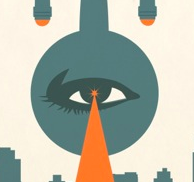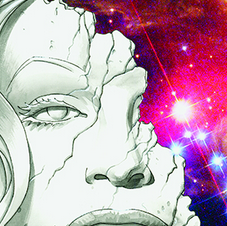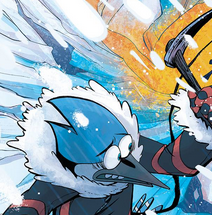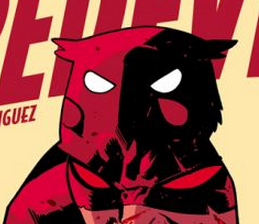Deadshirt Is Reading… is a weekly feature in which Deadshirt’s staff, contributing writers and friends-of-the-site offer their thoughts on a diverse array of comics, from name-brand cape titles to creator-owned books to webcomics.
Kayleigh Hearn is reading…
Written by Matt Fraction
Art by Chip Zdarsky
Image
“Bloop.”
Sex Criminals is back, and after the tremendous success of its first story arc, it has a lot to live up to. Suzie and Jon, the young couple who enter the frozen-time realm of The Quiet/Cumworld when they mutually orgasm, have stopped robbing banks after their violent confrontation with The Sex Police. No longer the X-rated Bonnie and Clyde, Suzie thinks their story is over (“We probably could have wrapped this up last issue, I guess,” she shrugs), but Jon thinks their troubles have only begun.
Issue #6 marks a different, darker direction for the comic, and readers expecting more sing-alongs to Queen may be confounded. If the first arc was like the best, most euphoric hook-up of your life, issue #6 is like the awkward, uncertain morning after. Jon and Suzie still have a lot to learn about each other, and Suzie soon sees Jon at his worst. Jon admits that he has “brain stuff” and, off his medication and fearful of the Sex Police, spirals into angry paranoia that leaves him desperate and calling Suzie for help. Their relationship feels tender and real, but will need more than reality-smashing sex to survive.
Chip Zdarsky’s art gives real, palpable emotion to his characters (how is Suzie so irresistible in every panel? Sorcery!) and his minimalist cover is as stunning as its predecessors. Matt Fraction’s writing is smart and perceptive even in its quietest moments; for example, when Suzie points out to Jon that women like to wear leggings because they’re comfortable, not because they want to drive men wild. The one really discordant note for me is the book’s depiction of Jon when he goes back on medication, and he is literally transformed into a colorless, dickless ghost. Portraying mental illness in fiction is a hugely complicated, messy thing, and while much of Jon’s struggles feel authentic, it’s disappointing to see the story fall back on that iffy cliché. Like its fellow Image comic Saga, Sex Criminals isn’t about how the star-crossed lovers get together, but how they can—or cannot—make their relationship work amidst the sci-fi strangeness surrounding them.
Max Robinson is reading…
Written by Ed Brubaker
Art by Sean Phillips (pencils and inks) and Elizabeth Breitweiser (colors)
Image
“And eyes like claws — Eyes like talons.”
The penultimate issue of Brubaker and Phillips’ decades-spanning Lovecraftian noir is finally here and boy do they pull out all the stops for this one. The bulk of this issue follows the series’ two leads, recently maimed author Nicholas Lash and the enigmatic Jo, finally having sex, and while that’s not exactly an uncommon occurrence in Fatale, the execution certainly is. Phillips’ art throughout the series has been reliable if not terribly experimental but that changes here in a big way as he incorporates actual(?) space photography into his psychedelic depiction of Jo and Nicholas’ coupling (the effect is very similar to what Jack Kirby did in some issues of Fantastic Four). It’s evocative in many ways of Swamp Thing #34, where Alan Moore portrayed the lead character and his human lover having sex in a hallucinatory, incorporeal sense rather than a physical one. It’s a massive departure from the book’s established visual style but it’s a bold choice that really pays off; Phillips’ art has never looked better.
While many of Fatale‘s sex scenes have been shrouded in shadow and fairly straightforward, there’s a real sense of vulnerability and intimacy to what we watch happen here. This is important because it really sells Brubaker’s major contribution to this issue, a huge reveal about Jo’s backstory. It’s something that’s briefly foreshadowed a few issues back but it’s nevertheless heartbreaking and genuinely uncomfortable in a way that great horror has to be. This issue really feels like both creators are at the top of their game, delivering an installment that’s gorgeous and creepy in ways both big and small (the quick double take moment with the owl might be a series highpoint). As we’re left on a hell of a cliffhanger and with even more questions than answers about Jo’s ultimate endgoal, next month’s oversized finale has quite a bit to live up to.
Dylan Roth is reading…
Written by Sarah Vaughn (story and script) & Jonathan Luna (story)
Art by Jonathan Luna
Image
“There’s something about you. Something going on behind the eyes.”
Alex + Ada is a true science fiction story, one that forces you to challenge your preconceived notions of ethics, of technology, of humanity itself. Also like a good science fiction, the ideas are conveyed through interesting characters. It’s a small, personal story set in a familiar near-future, but provides a peek into a larger world that raises issues about sentience, identity, and property that may become important in our lifetime.
In the world of Alex + Ada, it’s not uncommon for humans to own robotic servants, including lifelike humanoids. When lonely twentysomething Alex receives an android girlfriend as a gift, he breaks the law to unlock her full AI potential, awakening her from a state of docile servitude to one of true sentience. Now the android, Ada, is learning who she is apart from her programming, all while trying to keep her nature a secret from the outside world that would have her dismantled and her human companion thrown in jail.
This issue is an excellent example of why Alex + Ada is such a compelling melodrama, as Ada has some of her first interactions with humans since becoming unshackled. The humans she meets believe she’s a blank servant, so they’re not shy about saying what they think of her and androids in general around her. Some respond with fear, others with lust, or more innocent curiosity. Vaughn and Luna (who share story credit, while Vaughn writes most of the scripts) are excellent at crafting subtle character moments that let the reader dig deep into every page for subtext, and Luna’s artwork is the perfect companion, with some really excellent “acting” out of the characters. As the stakes of the story get higher, I’m curious to see if this quiet indie-movie of comic book expands from melodrama to thriller territory.
Joe Stando is reading…
Written by Kevin Burkhalter, Yumi Sakugawa, Jimmy Giegerich, and Andy Kluthe
Art by Tessa Stone, Allison Strejlav, Mad Rupert and Andy Kluthe, and Lisa Moore and Whitney Cogar (colors)
Lettered by Cory Breen
Kaboom! (Boom! Studios)
“In the wild there is only one rule: Finders, Keepers. This is part of a lesson I call Foraging for Nachos.”
Regular Show has been among my favorite Cartoon Network shows for a long time and I’ve been enjoying KC Green’s and Allison Strejlav’s work on the comic adaptation for a while now. They’ve found a solid groove in terms of telling new stories that feel true to the show’s characterization. This task seems deceptively simple, but not every back-up story has had the same flair, so I was eager to read multiple teams’ takes on the series.
Overall, it’s a decent showing, but I was underwhelmed at times. I think the biggest problem is the limitations on what characters can be used and what stories can be told. BOOM! is generally pretty lenient about storytelling in licensed comics, but with a collection of short stories like this, the guidelines become pretty clear. There’s nothing wrong with that, either; these IPs are TV shows first, so there need to be limits to keep to that spirit. But the Mordecai/Rigby dynamic, as amusing and relatable as it is, can wear kind of thin, and while these are good shorts, there’s an air of sameness at times.
That’s not to say I didn’t enjoy it, or that elements of it weren’t on par with the regular creative team or the animated series. I’ve been a fan of Tessa Stone’s art online for a long time, and her takes on the characters felt fresh and vibrant. The story was also a solid showcase for her designs, incorporating characters like Pops and the Basketball King. Similarly, Mad Rupert’s character design for the video game genie is maybe the most laugh-out-loud moment in the entire book and felt like it wouldn’t have been at all out of place in an episode. My favorite story was Andy Kluthe’s “Muscle Scouts”, partially because it focused on characters other than the core two protagonists, and partially because I felt that it nailed the tone and voice of the series so well. More than any other story, I could hear the characters’ voices in my head on this one, and a solo focus on Muscle Man outside of the context of Mordecai and Rigby is something we don’t get to see very often.
All in all, I felt like this was a good first showing for an annual. In the future, I think it would be cool to divide up characters among different creators, so we get a “Mordecai and Rigby hanging out” story, a story with the rest of the cast, a love interest story, etc. (and, dare I say it, a Hi-Five Ghost solo story?). But for now, it was a nice chance for various teams to provide their takes on the show’s core dynamics, even if it went to the same well a bit often.
Jason Urbanciz is reading…
 Star Trek: Harlan Ellison’s Original City on the Edge of Forever Teleplay #1
Star Trek: Harlan Ellison’s Original City on the Edge of Forever Teleplay #1
Original Teleplay by Harlan Ellison
Adaptation by Scott Tipton & David Tipton
Art by J.K. Woodward
Letters by Neil Uyetake
“You want me to give you a dream-narcotic they’ve banned all through the galaxy?”
“The City on the Edge of Forever” has long been hailed as the original Star Trek’s best episode. Indeed, it deals with many of the themes that resonate the strongest in the series and with its fans: the question of whether the needs of the many outweigh the life of one person, time travel and threats to the time stream, plus Kirk and Spock having bro-times. Famously written by Harlan Ellison and then altered by in-house writers to more fit the series and Gene Roddenberry’s vision, Ellison has long held that his original version was superior. Though it’s been published as a script a few times, this is the first time we’re getting a visual representation of what Ellison wanted. It’s certainly fine, but definitely not any better than the original episode.
While the first issue only covers the first ten minutes or so of the would-be episode, the differences are immediately apparent. While on TV the plot was set in motion by McCoy being inadvertently overdosed with space-medicine and going nuts, Ellison has a space-drug drug dealer going on the run, beaming down to a planet from which wild time distortions were emanating, and diving through a portal in time. Both versions are mostly the same, but the biggest difference here is that the comics form allows Ellison’s version to operate on a much grander scale. Gone is the light-up plastic arc that was the Guardian of Forever, and in its place is a massive crystalline city with giant celestial guardians.
The grandness of the art is also the comic’s biggest hinderance. J.K. Woodward’s art falls victim to a problem that plagues other painted work: it’s just too static. It’s like a collection of small portraits, and lacks any sense of movement or dynamism. On top of that, while his work on the faces of the main crewmembers is strong, anyone who wasn’t on the TV show suffers from being ill-defined, like he didn’t have enough reference for their faces and just kind of fudged it. This really starts the comic off on the wrong foot, since it opens with four pages of dialog between two characters who are original to the teleplay.
This comic is an interesting experiment in bringing a previously-unseen variation of a popular episode to life, but it’s only interesting as a novelty so far. There’s nothing here that raises it to the level of the original episode, and it helps show why Roddenberry may have made the correct choice in rewriting Ellison’s work.
David Lebovitz is reading…
Story by Mark Waid & Chris Samnee
Colors by Javier Rodriguez
Letters by VC’s Joe Carmagna
Marvel
“I have been where you are, but in my most desperate times, I have NEVER considered suicide by supervillain.” “Neither have…” “You can’t lie to me, Max!”
This issue continues the story of Daredevil’s time in San Francisco. Like most Daredevil issues of late, it shows how Matt got out of a seemingly inescapable predicament that concluded the previous issue. It follows Matt as he attempts to find the Shroud (Max Coleridge) and the Owl after their escape from the Owl’s mansion. Daredevil needs to find them before the Shroud falls victim to the Owl’s trickery and/or the Owl pulls off what he’s scheming – and it’s big.
While The Owl is the main villain of the story, he’s mostly there to keep the plot moving forward. The true heart of this storyline is the uneasy relationship between Daredevil and the Shroud. Matt and Max have switched between allies and enemies many times over these past few issues, but at their core they are both on the same side. Daredevil understands that Shroud is in over his head, and he’s made it his unstated mission not just the stop the Owl, but to help the Shroud get what he needs and get out alive. A highlight of the issue is the speech Daredevil gives after saving the Shroud yet again – it encapsulates who Daredevil is and what he stands for.
Waid and Samnee write the most fully-realized version of Daredevil since Brubaker’s run – they understand his strengths, weaknesses, and personality. They’re probably the most drift compatible writer/artist duo out there as well — if the extended panels in this issue that break down exactly how Murdock perceives complex actions are any indication, they’re doing the art and the writing together as tightly as possible. I sincerely hope we see these two on the title for a long time.
Thanks for reading about what we’re reading! We’ll be back next week with a slew of suggestions from across the comics spectrum. In the meantime, what are you reading? Tell us in the comments section, on Twitter or on our Facebook Page!






